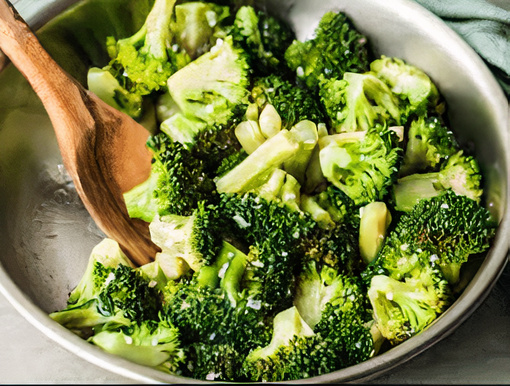Benefits of Broccoli 🥦| Without Losing Its Nutrients Benefits And Health Facts
🥦Broccoli is an edible bright green or purple plant with a flowering head, sturdy stalk, and nutrient-dense leaves. It belongs to the Brassicaceae family–home to cruciferous vegetables such as cabbage, kale, cauliflower, and Brussels sprouts – How to cook broccoli without losing its nutrients?
And is rich in nutrients that can help improve your health inside and out. It can be eaten in various ways: raw, roasted, steamed, sautéed, and even battered and fried. You can avail benefits of the broccoli ketogenic diet.

Table of Contents
Health Benefits of Broccoli:
The U.S.A. states that in every edible part of the brut plant, even the stems, the health benefits of broccoli-like vitamin K. It has a wealth of nutrients that can proactively or effectively improve overall health.
The method of cooking can affect the health benefits. The best way to maximize this cruciferous vegetable is to make raw broccoli while steaming broccoli decreases the effect.
- Beta carotene boosts the immune system.
- Dietary fiber aids the digestive system.
- For bone health Vitamin A is.
- Vitamin E can enrich the skin and make it look radiant.
- Vitamin C may decrease the allergy effect.
Here are the top 14 health benefits of broccoli :
1. Packed With Vitamins, Minerals, and Bioactive Compounds :
The broccoli nutrient facts have a wide range of vitamins, minerals, fiber, and other bioactive compounds available here.
It can be eaten raw or cooked — both of which are healthy but have different nutrient profiles. The vegetable nutrient composition, particularly reducing vitamin C and soluble proteins and sugar, is altered by different cooking methods, such as boiling, microwaving, stir-frying, and steaming.
The least negative effects appear to be steaming. Nevertheless, this holy vegetable is an excellent source of vitamin C source, raw or cooked. Just half a cup of cooked broccoli provides 84 percent of the reference daily intake (R.D.I).
2. Contains Potent Antioxidants That Offer Health-Protective Effects :
One of its main benefits for human health can be the antioxidant content of broccoli. Antioxidants are molecules that inhibit or neutralize free radicals’ cell damage.
This can lead to lower inflammation and a healthcare effect in general. For example, crunchy broccoli has large glucoraphanin levels, which are transformed during digestion into a powerful antioxidant known as sulforaphane.
3. May Contribute to Reduced Inflammation :
Broccoli contains different bioactive compounds, which have shown that your body tissue reduces inflammation. Multiple compounds are theoretically supported by synergistic means, although some appear to function individually.
A small study of human tobacco smokers also showed that consumption of Brockley vegetables led to an important reduction of inflammatory markers.
4. Protect Against Certain Types of Cancer :
Cruciferous vegetables like simple broccoli contain a range of bioactive compounds to reduce chronic disease cell harm. In addition, various small studies indicated the protection against certain types of cancer by eating cruciferous vegetables.
5. Fiber May Aid Blood Sugar Control :
In people with diabetes, eating blanched broccoli florets can improve blood sugar control. While the exact mechanism is unknown, it can be linked to the antioxidant content of raw broccoli.
An individual study has shown significantly lower insulin resistance in people with type 2 diabetes who consume clean broccoli daily for a month.
6. May Support Heart Health in a Variety of Ways :
Several studies have shown that broccoli can support heart health, in several ways. For example, higher “bad” levels of LDL and triglyceride are known to be the key cardiac risk factors. Limp broccoli may be instrumental in the improvement of these markers.
7. Promotes Healthy Digestion and Reduced Constipation :
Broccoli is rich in fiber and antioxidants — both of which may support healthy bowel function and digestive health.
Bowel regularity and a strong community of healthy bacteria within your colon are two vital components of digestive health. Eating fiber- and antioxidant-rich foods like It may play a role in maintaining healthy gut function.
8. Slow Mental Decline and Support Healthy Brain Function :
Crispy and crunchy broccoli quick way is rich in fiber and antioxidants, which can support the healthy function of the bowel and digestion.
Bowel regularity is two essential components of digestion health and the strong community of healthy bacteria in your colon. Maintenance of healthy gut function can include eating fiber- and antioxidant-rich foods
9. Healthy Brain Function Slow Mental Decline :
Some broccoli nutrients and bioactive compounds can slow down in mind and promote healthy function of the brain and nerves.
Oxidative stress and reduced metabolic function are largely attributed to the aging process throughout your life. Although aging is a natural, inevitable process, dietary quality plays an important role in determining age-related diseases’ genetic expression and development.
10. Encourages a healthy immune system :
The human immune system is complex, with a large number of nutrients. The most important nutrient for immune function is vitamin C, which carries the burden of broccoli. Vitamin C is generally linked to oranges, but broccoli deserves credit – 84 percent of this R.D.I. is a half cup of cooked broccoli for this vitamin.
11. Enhance oral health :
Green broccoli contains a broad range of nutrients, some of which are known for oral health and dental health prevention. For example, broccoli, two nutrients linked to a reduced risk of periodontal illness, is a good vitamin C and calcium source. Kaempferol can also play a role in the prevention of periodontitis, a flavonoid found in green vegetable broccoli.
12. Protect Your Skin From Sun Damage :
Skin cancer is increasing partly as a result of the damaged ozone layer and increased U.V. rays exposure.
More research is ultimately required to understand how raw broccoli and its bioactive components protect the skin against sun damage.
13. Healthy bones :
Many nutrients in broccoli support healthy bones and can prevent disorders related to bone. For example, broccoli is a good source of K vitamin and calcium, two essential nutrients to keep the bones strong and healthy.
14. Content may promote healthy embryos :
Your body needs various vitamins, minerals, and proteins to support both mother and baby during pregnancy.
For example, broccoli food is a good source of B vitamin — B9 also referred to as folate. For the development of the fetal brain and backbone, folate is a critical nutrient.
Therefore, regular intake of folate-rich foods such as vegetables and seasoned broccoli can contribute to a healthy pregnancy.
How to Cook Broccoli?

It need not be cooked as a cut into a salad, but it only gets an extra earthy taste with heat. This is a side dish that offsets a delicious meal, which is sprinkled with a bowl, steamed for a quick snack, puréed into pasta sauce, roasted on the stoves to be mixed with the chicken, or served on lentils, rice, quinoa, or other grains using a drizzle of olive oil.
But the confusion is how do you cook broccoli? Sometimes diet conscious people have to skip their carbs and only focus on fiber and low-calorie food. So, We have elaborated on all the best ways to enjoy a healthy diet.
Cooking Method #1: How to cook broccoli using ice?

The best way to cook broccoli in which fresh broccoli is put in boiling water and removed after a brief interval of time directly put in ice-cold water to stop the cooking process is named Blanching. A bowl of ice water prepare and bring it to the kitchen. Bring a big water pot to a fast boil.
Add a tablespoon of salt to the heap. and add steamed broccoli raw and fresh broccoli cook for 1 to 1 ½ minutes, until tender.
Remove from the ice water immediately with a slotted spoon. Let the water boil again, and then cook the stems, for 1 ½ to 2 minutes, until they’re crisp-tender too.
The most important thing is how long to steam broccoli. Cook for another 30 seconds if you want softer vegetables.
→ Applications for white broccoli: vegetable plates, cold salads, frittatas, and other pans.
Cooking Method #2: How long to steam broccoli in the Microwave

Put the broccoli in a safe microwave dish and pour over 2 to 3 tablespoons of water. Let me assure you that it is the easiest way to get steamed broccoli. Cover on high for 3 to 4 minutes with a dining table and a microwave.
Carefully remove the lid and verify that it is soft enough. Additional 1-minute microwave explosions if needed. This is the easiest steamed broccoli recipe. Low carbs in broccoli make this vegetable special.
→Steamed broccoli sprinkled with olive oil and served as a seasoning sideline dish, warm salads, frittatas and casseroles, and soups.
Cooking Method #3: Steamed broccoli on the Stovetop

How is broccoli made with boiled chicken or some steamy items? Fill a pot with a few centimeters of water and put a basket of steamer on top. Make sure the floor of the steamer basket doesn’t reach the water. Put the water on low-to-low heat and dry.
Add blooms and stalks and cover with broccoli. Steam for 4 to 5 minutes until tender. Boiling time should keep into consideration because it is the trickiest part of this method is how long to boil broccoli.
→ Boiled broccoli is consumed as a seasoning side dish, in warm salads, frittatas, and casseroles, soups.
Cooking Method #4: Saute Broccoli or How to cook broccoli on the stove?

Make it as dry as possible for broccoli (you can skip rinsing underwater if your broccoli seems clean). Move an oil saucepan and place over medium to high heat.
Flowers and a large pinch of salt are added. Take 1 minute to add the stems. Continue to cook, often stirring until the broccoli is tender and bright green.
→ Uses of broccoli sautéed: vegetable sautés, seasoning side dish.
Cooking Method #5: Roasted Broccoli Recipe or baked broccoli

Knowing the answer to how to roast broccoli is a bit difficult. Because it is the game of temperature.For broccoli recipes at 425°F, heat the oven. Make it as dry as possible for big broccoli (you can skip rinsing underwater if your broccoli seems clean).
Many people have doubts about the cooking of broccoli in the oven. Throw the broccoli with some oil teaspoons and a half-salt teaspoon.
Disseminate the broccoli into a single layer on a foil-lined baking sheet. Roast broccoli for 20 to 25 minutes, and you see deeply caramelized brown spots until the broccoli is crisp. Serve straight away.
→ Calories in Broccoli: side meat, cold and warm salads, topping with pizza (slightly below roast to prevent broccoli from burning on a pizza)
Ketogenic food:

The best Broccoli recipe is low-carbohydrate food with a serving size of 1 cup of about 6 grams is best for a protein diet. Keto food fans think the food should be used as a base rather than pasta or rice.
However, it is worthwhile to use. In keto, people cut off all carbohydrates or consume food with low carbohydrates and increase the protein portions to burn fat fast.
Freshly cooked broccoli is a gift for them. How to cook fresh broccoli is well explained in the above section. During intermittent fasting, this veggie will be your best friend because it is low-carb food. On Youtube, you can check details about ketogenic food.







